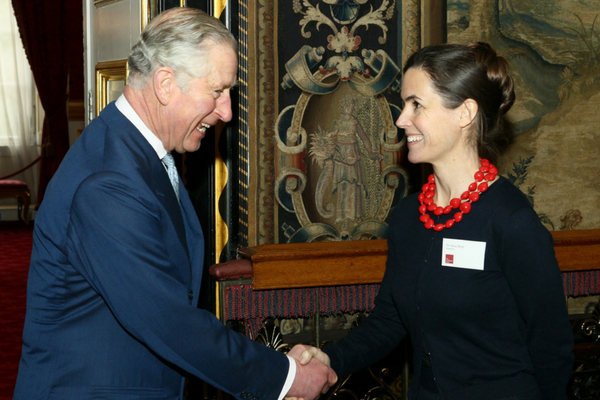
At an event at St. James’s Palace hosted by our Patron HRH The Prince of Wales in celebration of our 50th anniversary, we renewed the commitment to our charity’s bold mission to save irreplaceable threatened historic buildings. At a lunch reception attended by 200 of our supporters, we announced our intention to target particularly neglected building categories. Guests at the event enjoyed sparkling wine that was generously provided by Nyetimber.
For 50 years we have been rescuing crumbling and collapsing buildings that span Britain’s social, military and economic history. Many of these ‘Landmarks’ have been unconventional and unusual. They include the world's first industrial housing at Cromford in Derbyshire, rescued from demolition in the 1970s; the derelict engine house of a Cornish arsenic mine and a decaying Martello Tower built in 1812 to counter the threat of Napoleon.
Our Director, Dr Anna Keay, said:
"While small, Landmark has always been innovative and that spirit is alive and well. In 2012 we broke new ground in using a contemporary architect to effect the revival of Astley Castle. Now we want to make sure we are pioneering the rescue of the most overlooked buildings which played an important part in our history but are in danger of being lost altogether."
Over 54,000 people now enjoy breaks in one of our 196 Landmarks each year. And whilst lettings income pays for the maintenance of our buildings (on average, a stay is £45 per person per night), we rely upon private supporters and grant-making bodies to fund our future rescue projects. The hardest stage of this is at the very beginning when initial surveys determine if and how a precarious building can be saved. Landmark’s Pioneer scheme supports these challenging and often risky first stages.
As its Patron, HRH The Prince of Wales has long been an active supporter of the Landmark Trust. To reflect this longstanding commitment to the work of the Trust, The Prince was made an Honorary Landmark Trust Pioneer during the reception at St James's Palace. The Prince recently visited Llwyn Celyn, a decaying Grade I- listed late-medieval building in the Black Mountains in Wales and one of the charity’s current live projects. The Prince of Wales, accompanied by The Duchess of Cornwall, also attended the opening of another of Landmark’s buildings at Hougoumont, Belgium, to mark the bicentenary of the Battle of Waterloo last June.
We have identified some challenging categories of buildings that contain threatened yet inspirational pieces of Britain’s past that the nation is in danger of losing forever. These are the building types that often proliferate on the Buildings At Risk registers because they are the most ‘difficult’ to save.
These categories are:
• 20th-century military structures such as control towers or bunkers
• Small and significant industrial buildings
• Seaside and leisure buildings such as pavilions and villas
• Transport and communications structures like signal boxes and semaphore towers
• Remote and unchanged rural domestic houses and crofts
• Buildings whose restoration may contribute to urban regeneration, especially in the Midlands and Northern cities.
We firmly believe that such buildings can become enjoyable places to stay, and so be saved for the nation. We will always be interested in the kinds of buildings at risk with which the charity is more normally associated, such as follies or towers, but we are keen to see them joined by other building types.
If you wish to propose a building please see how we acquire buildings, after which please contact Alastair Dick-Cleland at [email protected]. We look for buildings that are of great importance historically or architecturally; that are physically at risk or in dire need of a new use to survive, and that are places where people will want to spend a holiday. We typically take on two or three a year and it may take several years of fundraising to secure a buildings future. Please also note that we do not buy buildings except in exceptional cases.
We have identified some challenging categories of buildings that contain threatened yet inspirational pieces of Britain’s past that the nation is in danger of losing forever. These are the building types that often proliferate on the Buildings At Risk registers because they are the most ‘difficult’ to save.
These categories are:
· 20th-centurary military structures such as control towers or bunkers
· Small and significant industrial buildings
· Seaside and leisure buildings such as pavilions and villas
· Transport and communications structures like signal boxes and semaphore towers
· Remote and unchanged rural domestic houses and crofts
· Buildings whose restoration may contribute to urban regeneration, especially in the Midlands and Northern cities.
We firmly believe that such buildings can become enjoyable places to stay, and so be saved for the nation. We will always be interested in the kinds of buildings at risk with which the charity is more normally associated, such as follies or towers, but we are keen to see them joined by other building types.
If you wish to propose a building please see our most frequently asked questions about how we acquire buildings, after which please contact Caroline Stanford, our Historian, at [email protected]. We look for buildings that are of great importance historically or architecturally; that are physically at risk or in dire need of a new use to survive, and that are places where people will want to spend a holiday. We typically take on two or three a year and it may take several years of fundraising to secure a buildings future. Please also note that we do not buy buildings except in exceptional cases.